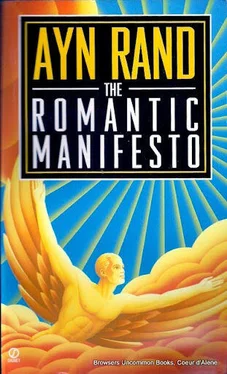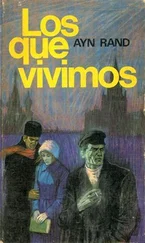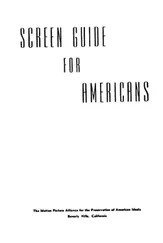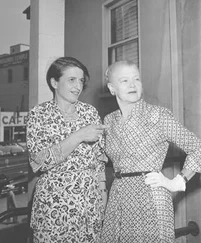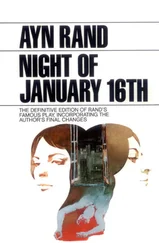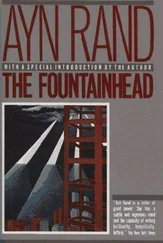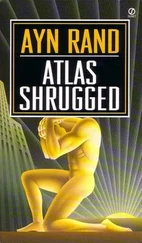Regardless of the nature or content of an artist’s metaphysical views, what an art work expresses, fundamentally, under all of its lesser aspects is: “ This is life as I see it.” The essential meaning of a viewer’s or reader’s response, under all of its lesser elements, is: “ This is (or is not ) life as I see it.”
The psycho-epistemological process of communication between an artist and a viewer or reader goes as follows: the artist starts with a broad abstraction which he has to concretize, to bring into reality by means of the appropriate particulars; the viewer perceives the particulars, integrates them and grasps the abstraction from which they came, thus completing the circle. Speaking metaphorically, the creative process resembles a process of deduction; the viewing process resembles a process of induction.
This does not mean that communication is the primary purpose of an artist: his primary purpose is to bring his view of man and of existence into reality; but to be brought into reality, it has to be translated into objective (therefore, communicable) terms.
In Chapter 1, I discussed why man needs art—why, as a being guided by conceptual knowledge, he needs the power to summon the long chain and complex total of his metaphysical concepts into his immediate conscious awareness. “He needs a comprehensive view of existence to integrate his values, to choose his goals, to plan his future, to maintain the unity and coherence of his life.” Man’s sense of life provides him with the integrated sum of his metaphysical abstractions; art concretizes them and allows him to perceive—to experience —their immediate reality.
The function of psychological integrations is to make certain connections automatic, so that they work as a unit and do not require a conscious process of thought every time they are evoked. (All learning consists of automatizing one’s knowledge in order to leave one’s mind free to pursue further knowledge.) There are many special or “cross-filed” chains of abstractions (of interconnected concepts) in man’s mind. Cognitive abstractions are the fundamental chain, on which all the others depend. Such chains are mental integrations, serving a special purpose and formed accordingly by a special criterion.
Cognitive abstractions are formed by the criterion of: what is essential ? (epistemologically essential to distinguish one class of existents from all others). Normative abstractions are formed by the criterion of: what is good ? Esthetic abstractions are formed by the criterion of: what is important ?
An artist does not fake reality—he stylizes it. He selects those aspects of existence which he regards as metaphysically significant—and by isolating and stressing them, by omitting the insignificant and accidental, he presents his view of existence. His concepts are not divorced from the facts of reality—they are concepts which integrate the facts and his metaphysical evaluation of the facts. His selection constitutes his evaluation: everything included in a work of art—from theme to subject to brushstroke or adjective—acquires metaphysical significance by the mere fact of being included, of being important enough to include.
An artist (as, for instance, the sculptors of Ancient Greece) who presents man as a god-like figure is aware of the fact that men may be crippled or diseased or helpless; but he regards these conditions as accidental, as irrelevant to the essential nature of man—and he presents a figure embodying strength, beauty, intelligence, self-confidence, as man’s proper, natural state.
An artist (as, for instance, the sculptors of the Middle Ages) who presents man as a deformed monstrosity is aware of the fact that there are men who are healthy, happy or confident; but he regards these conditions as accidental or illusory, as irrelevant to man’s essential nature—and he presents a tortured figure embodying pain, ugliness, terror, as man’s proper, natural state.
Now consider the painting described at the start of this discussion. The cold sore on the lips of a beautiful woman, which would be insignificant in real life, acquires a monstrous metaphysical significance by virtue of being included in a painting. It declares that a woman’s beauty and her efforts to achieve glamor (the beautiful evening gown) are a futile illusion undercut by a seed of corruption which can mar and destroy them at any moment—that this is reality’s mockery of man—that all of man’s values and efforts are impotent against the power, not even of some great cataclysm, but of a miserable little physical infection.
The Naturalistic type of argument—to the effect that, in real life, a beautiful woman might get a cold sore—is irrelevant esthetically. Art is not concerned with actual occurrences or events as such, but with their metaphysical significance to man.
An indication of the metaphysical slant of art can be seen in the popular notion that a reader of fiction “identifies himself with” some character or characters of the story. “To identify with” is a colloquial designation for a process of abstraction: it means to observe a common element between the character and oneself, to draw an abstraction from the character’s problems and apply it to one’s own life. Subconsciously, without any knowledge of esthetic theory, but by virtue of the implicit nature of art, this is the way in which most people react to fiction and to all other forms of art.
This illustrates one important aspect of the difference between a real-life news story and a fiction story: a news story is a concrete from which one may or may not draw an abstraction, which one may or may not find relevant to one’s own life; a fiction story is an abstraction that claims universality, i.e., application to every human life, including one’s own. Hence one may be impersonal and indifferent in regard to a news story, even though it is real; and one feels an intensely personal emotion about a fiction story, even though it is invented. This emotion may be positive, when one finds the abstraction applicable to oneself—or resentfully negative, when one finds it inapplicable and inimical.
It is not journalistic information or scientific education or moral guidance that man seeks from a work of art (though these may be involved as secondary consequences), but the fulfillment of a more profound need: a confirmation of his view of existence—a confirmation, not in the sense of resolving cognitive doubts, but in the sense of permitting him to contemplate his abstractions outside his own mind, in the form of existential concretes.
Since man lives by reshaping his physical background to serve his purpose, since he must first define and then create his values—a rational man needs a concretized projection of these values, an image in whose likeness he will re-shape the world and himself. Art gives him that image; it gives him the experience of seeing the full, immediate, concrete reality of his distant goals.
Since a rational man’s ambition is unlimited, since his pursuit and achievement of values is a lifelong process—and the higher the values, the harder the struggle—he needs a moment, an hour or some period of time in which he can experience the sense of his completed task, the sense of living in a universe where his values have been successfully achieved. It is like a moment of rest, a moment to gain fuel to move farther. Art gives him that fuel; the pleasure of contemplating the objectified reality of one’s own sense of life is the pleasure of feeling what it would be like to live in one’s ideal world.
“The importance of that experience is not in what man learns from it, but in that he experiences it. The fuel is not a theoretical principle, not a didactic ‘message, ’ but the life-giving fact of experiencing a moment of metaphysical joy—a moment of love for existence.” (See Chapter 11.)
Читать дальше
